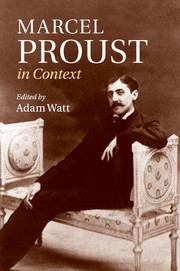Book contents
- Frontmatter
- Contents
- List of Illustrations
- Notes on contributors
- Figure I. Marcel Proust, portrait in oils by Jacques-Émile Blanche, 1892
- Preface
- Figure 2. Proust photographed on his death-bed by Man Ray, 1922
- Note on the text
- Chronology
- Part I Life and works
- Part II Historical and cultural contexts
- Part III Critical reception
- Chapter 24 Critical reception during Proust's lifetime
- Chapter 25 Early critical responses, 1922 to 1950s
- Chapter 26 Mid-twentieth-century views, 1960s to 1980s
- Chapter 27 Late-twentieth- and twenty-first-century responses
- Chapter 28 Modernism
- Chapter 29 Adaptations/afterlives
- Chapter 30 Translations
- Further reading
- Index
- References
Chapter 29 - Adaptations/afterlives
from Part III - Critical reception
Published online by Cambridge University Press: 05 November 2013
- Frontmatter
- Contents
- List of Illustrations
- Notes on contributors
- Figure I. Marcel Proust, portrait in oils by Jacques-Émile Blanche, 1892
- Preface
- Figure 2. Proust photographed on his death-bed by Man Ray, 1922
- Note on the text
- Chronology
- Part I Life and works
- Part II Historical and cultural contexts
- Part III Critical reception
- Chapter 24 Critical reception during Proust's lifetime
- Chapter 25 Early critical responses, 1922 to 1950s
- Chapter 26 Mid-twentieth-century views, 1960s to 1980s
- Chapter 27 Late-twentieth- and twenty-first-century responses
- Chapter 28 Modernism
- Chapter 29 Adaptations/afterlives
- Chapter 30 Translations
- Further reading
- Index
- References
Summary
An 1892 photograph portrays an unusually relaxed, clowning Proust strumming a tennis racquet in playful serenade (see Fig. 3). Such an appropriative gesture – such dislocation, manipulation and transformation of tennis racquet into banjo – provides a point of departure for scrutiny of the cultural manipulations and transformations undergone by Proust's work itself. How might we understand the appropriation of his œuvre within popular culture? In this exuberant encounter, what has become of Proust's ‘aura’: the effect analysed by Walter Benjamin as marker of the singularity of the work of art, of the compelling ‘here-and-now-ness’ of its unique presence, the immediacy of its power? Benjamin was thinking of visual works of art, in particular, as he argued that it is precisely these elements of singularity and immediacy of the work of art that cannot be mechanically reproduced. For Benjamin, such elements have to do with the work of art's particular embeddedness within a tradition. Yet something has happened to the here-and-nowness of Proust's work; it has been appropriated and manipulated within popular culture, detached from its own tradition and converted into a very different contemporaneity.
Curiously, however, Proust is – in the claim of one reader – ‘cooler than you are’, having already anticipated and charted the course of such activity. The encounter with popular culture, far from signalling the demise of Proust, renews the Proustian aura, bringing a different ‘here-and-now-ness’ to the Proustian text. For popular culture's episodic, scattered and idiosyncratic appropriations reveal in its popularized Proust an activity of cultural resistance. Popular culture is everyday culture, and within its everyday Proust thrives a lively resistance that Certeau teaches us to see. Arguing for reading not as passive ingestion, but as a kind of poaching, Certeau suggests that such appropriation acts as resistance to the imposition of massive cultural norms. Whereas we might understand Marcel's long apprenticeship in aesthetics precisely as an effort to absorb the aesthetic ‘habitus’ – in Bourdieu's term – of the true artist, we find in Marcel's contemporary reader precisely the reverse of such absorption: we find the resistance to such cultural inculcation. For today's reader, then, the Recherche provides not only a map for such cultural absorption (the Bourdieu reading), but a map for its resistance (the Certeau reading).
- Type
- Chapter
- Information
- Marcel Proust in Context , pp. 221 - 229Publisher: Cambridge University PressPrint publication year: 2013



